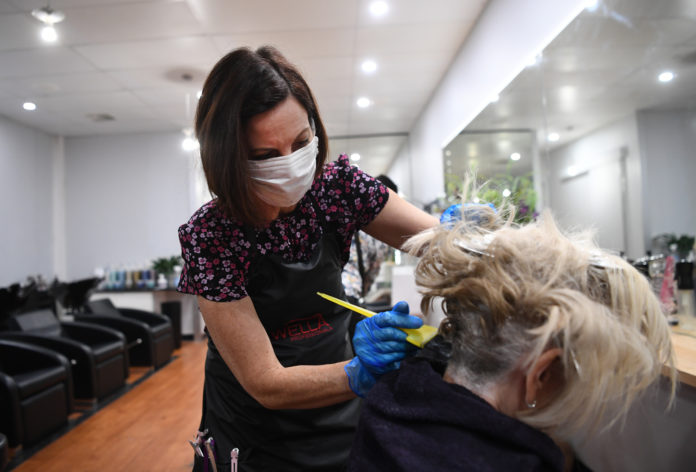Source: The Conversation (Au and NZ) – By Hannah McCann, Lecturer in Cultural Studies, University of Melbourne
As part of sweeping social-distancing measures, on March 24 Prime Minister Scott Morrison announced nail salons, tanning, waxing and most other beauty services would be closed – but hair salons could remain open with a 30-minute per client time restriction.
There was much criticism this limit was both unfeasible and highly gendered, and it was reversed. Salons can operate if they maintain one person per four square metres.
While many hairdressing businesses have voluntarily closed their doors, others remain open. The issue has become a flashpoint in Australia for debate about what is an “essential” service.
Touch and talk
My previous research on the emotional aspects of salon work has shown hairdressers and beauty workers act like makeshift counsellors for many clients.
The salon is not just about makeovers: it is a space of touch and talk. For some, the salon might be one of the only places they encounter regular verbal and physical contact. Increasingly, salon workers are being recognised as an important channel between members of the community and services such as family violence shelters.Read more: More than skin deep, beauty salons are places of sharing and caring
In ordinary circumstances, hair and beauty services might be considered essential due to the social and community welfare aspects of the job. However, in the context of a pandemic the close proximity required for hairdressing is a problem.
Fearing for the well-being of those in the industry, the Australian Hairdressing Council has petitioned the government for hairdressers and barbers to be shut down. The initial mixed messages about rules for salons appear to have created confusion for salons and customers alike. This includes uncertainty about what subsidies are available for salons that have already closed voluntarily.
It is not yet clear why the government continues to deem hair services “essential”. Given the original 30-minute ruling, it is unlikely the decision is based on concern for the maintenance of the social work aspects of hairdressing.
The 67,000 people employed as hairdressers may be a more significant factor in the decision at a time when so many others have lost their jobs. Of course, the shutdown has already affected the 36,100 beauty therapists employed across Australia, but there may be an impression much beauty work (such as maintaining nails and body hair) can be done at home.
There may also be a gendered element to this: these beauty services are more frequented by women and therefore may be more culturally coded as “inessential” or frivolous.
It seems likely we would follow the lead of other countries that have already closed hair salons if further physical distancing measures are required.
Digital salons
In times of severe economic downturn, hair and beauty services remain popular.
Even during the Great Depression people continued to pay for salon visits, forgoing other essentials.
However, the length of time between salon visits appears to expand in times of downturn. Dubbed the “haircut index”, consumer confidence is thought to be signalled by more frequent trips. On the flip side, some argue consumers tend to buy more small luxury beauty items such as lipstick during recession (the so-called “lipstick index”).
Even in difficult economic periods, people still care about keeping up appearances.
In the context of COVID-19, however, social distancing complicates the situation for the beauty industry.
With many shopfronts closed already, businesses have shifted to online services, finding creative ways to maintain connections with existing clients.
Many salons have begun selling “lockdown” product packs online, producing short “home maintenance” videos, and some are even offering one-on-one live digital consultations.
Then there are some who are simply taking matters into their own hands.
Google Trends reveal an exponential increase in searches for “how to cut your own hair” since March 8. Buzzcuts are also gaining popularity as a no-fuss way to maintain short hair at home. People appear to be using the lack of salon guidance as an opportunity to get inventive with their appearance, or to try things at home they might be too scared to ask for from a professional.
Limited social contact and the availability of online filters mean people might feel they can get more creative with their style. #hairtutorials continues to trend on TikTok. #QuarantineHair is being used on Twitter to document some of the highs and lows people are having experimenting with their looks in lockdown.
Zoom beauty
While it may seem ludicrous to some that people still care about makeup and hair products during a public health crisis, there are multiple reasons why this may be the case. Though sociality is reduced, many entrenched beauty norms will persist. People may feel the need to keep up some sense of appearance while still seeing colleagues, clients and friends on screen.
There is also an important ritual element to maintaining one’s appearance. In Western culture, one’s outer presentation is seen as intimately connected to one’s sense of identity and well-being. Maintaining a daily routine, including skin care, putting on makeup and styling one’s hair, might give some people a sense they are looking after themselves – especially when other things around them are much harder to control.
At the very least, sharing mishaps and humorous experiences with self-styling in this digital beauty world offers people a new way to gain a sense of social connection.
– ref. Coronavirus shutdowns: what makes hairdressing ‘essential’? Even the hairdressers want to close – https://theconversation.com/coronavirus-shutdowns-what-makes-hairdressing-essential-even-the-hairdressers-want-to-close-135811









